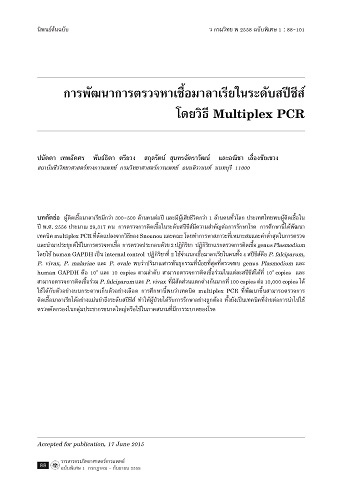การพัฒนาการตรวจหาเชื้อมาลาเรียในระดับสปีชีส์ โดยวิธี Multiplex PCR
คำสำคัญ:
multiplex PCR, Plasmodium sp., malaria detection, recombinant plasmid DNAบทคัดย่อ
ผู้ติดเชื้อมาลาเรียมีกว่า 300-500 ล้านคนต่อปี และมีผู้เสียชีวิตกว่า 1 ล้านคนทั่วโลก ประเทศไทยพบผู้ติดเชื้อในปี พ.ศ. 2556 ประมาณ 29,317 คน การตรวจการติดเชื้อในระดับสปีชีส์มีความสำคัญต่อการรักษาโรค การศึกษานี้ได้พัฒนาเทคนิค multiplex PCR ที่ดัดแปลงจากวิธีของ Snounou และคณะ โดยทำการหาสภาวะที่เหมาะสมและค่าต่ำสุดในการตรวจและนำมาประยุกต์ใช้ในการตรวจหาเชื้อ การตรวจประกอบด้วย 2 ปฏิกิริยา ปฏิกิริยาแรกตรวจการติดเชื้อ genus Plasmodium โดยใช้ human GAPDH เป็น internal control ปฏิกิริยาที่ 2 ใช้จำแนกเชื้อมาลาเรียในคนทั้ง 4 สปีชีส์คือ P. falciparum, P. vivax, P. malariae และ P. ovale พบว่าปริมาณสารพันธุกรรมที่น้อยที่สุดที่ตรวจพบ genus Plasmodium และ human GAPDH คือ 103 และ 10 copies ตามลำดับ สามารถตรวจการติดเชื้อร่วมในแต่ละสปีชีส์ได้ที่ 103 copies และสามารถตรวจการติดเชื้อร่วม P. falciparum และ P. vivax ที่มีสัดส่วนแตกต่างกันมากที่ 100 copies ต่อ 10,000 copies ได้ใช้ได้กับตัวอย่างบนกระดาษเก็บตัวอย่างเลือด การศึกษานี้พบว่าเทคนิค multiplex PCR ที่พัฒนาขึ้นสามารถตรวจการติดเชื้อมาลาเรียได้อย่างแม่นยำถึงระดับสปีชีส์ ทำให้ผู้ป่วยได้รับการรักษาอย่างถูกต้อง ทั้งยังเป็นเทคนิคที่ง่ายต่อการนำไปใช้ตรวจคัดกรองในกลุ่มประชากรขนาดใหญ่หรือใช้ในภาคสนามที่มีการระบาดของโรค
เอกสารอ้างอิง
กรมควบคุมโรค. โรคมาลาเรีย. [ออนไลน์]. 2557; [สืบค้น 4 ธ.ค. 2557]; [2 หน้า]. เข้าถึงได้จาก : URL: https://www.boe.moph.go.th/fact/Malaria.htm
Johnston SP, Pieniazek NJ, Xayavong MV, Slemenda SB, Wilkins PP, da Silva AJ. PCR as a confirmatory technique for laboratory diagnosis of malaria. J Clin Microbiol 2006; 44(3): 1087-9.
Brown AE, Kain KC, Pipithkul J, Webster HK. Demonstration by the polymerase chain reaction of mixed Plasmodium falciparum and Plasmodium vivax infections undetected by conventional microscopy. Trans R Soc Trop Med Hyg 1992; 86(6): 609-12.
Pieroni P, Millis CD, Ohrt C, Harrington MA, Kain KC. Comparison of the Parasite-F test and the ICT malaria Pf test with the polymerase chain reaction for the diagnosis of Plasmodium falciparum malaria in travellers. Trans R Soc Trop Med Hyg 1998; 92(2): 166-9.
Tham JM, Lee SH, Tan TMC, Ting RCY, Kara UAK. Detection and species determination of malaria parasites by PCR: comparison with microscopy and with Parasite-F and ICT malaria Pf test in clinical environment. J Clin Microbiol 1999; 37(5): 1269-73.
Weiss JB. DNA probes and PCR for diagnosis of parasitic infections. Clin Microbiol Rev 1995; 8: 113-30.
Isozumi R, Fukui M, Kaneko A, Chan CW, Kawamoto F, Kimura M. Improved detection of malaria cases in island settings of Vanuatu and Kenya by PCR that targets the Plasmodium mitochondrial cytochrome c oxidase III (cox3) gene. Parasitol Int 2015; 64(3): 304-8.
Blood parasites. In: World Health Organization. Basic laboratory methods in medical parasitology. Geneva: WHO; 1997. p.81.
Snounou G, Viriyakosol S, Zhu XP, Jarra W, Pinheiro L, do Rosario VE, et al. High sensitivity of detection of human malaria parasites by the use of nested polymerase chain reaction. Mol Biochem Parasitol 1993; 61(2): 315-20.
Lee PC, Chong ETJ, Anderios F, Lim YAL, Chew CH, Chua KH. Molecular detection of human Plasmodium species in Sabah using PlasmoNexTM multiplex PCR and hydrolysis probes real-time PCR. Malar J 2015; 14: 28-34.
Bialasiewicz S, Whiley DM, Nissen MD, Sloots TP. Impact of competitive inhibition and sequence variation upon the sensitivity of malaria PCR. J Clin Microbiol 2007; 45(5): 1621-3.
Mixson-Hayden T, Lucchi NW, Udhayakumar V. Evaluation of three PCR-based diagnostic assays for detecting mixed Plasmodium infection. BMC Res Notes 2010; 3: 88-94.
Mens P, Spieker N, Omar S, Heijnen M, Schallig H, Kager PA. Is molecular biology the best alternative for diagnosis of malaria to microscopy? A comparison between microscopy, antigen detection and molecular tests in rural Kenya and urban Tanzania. Trop Med Int Health 2007; 12(2): 238-44.
Gal S, Fidler C, Truner S, Lo YM, Roberts DJ, Wainscoat JS. Detection of Plasmodium falciparum DNA in plasma. Ann N Y Acad Sci 2001; 945: 234-8.
Roper C, Elhassan IM, Hviid L, Giha H, Richardson W, Babiker H, et al. Detection of very low level of Plasmodium falciparum infections using the nested polymerase chain reaction and a reassessment of the epidemiology of unstable malaria in Sudan. Am J Trop Med Hyg 1996; 54(4): 325-31.
Kimura M, Miyake H, Kim HS, Tanabe M, Arai M, Kawai S, et al. Species-specific PCR detection of malaria parasites by microtiter plate hybridization: clinical study with malaria patients. J Clin Microbiol 1995; 33(9): 2342-6.
Kho WG, Chung JY, Sim EJ, Kim MY, Kim DW, Jongwutiwes S, et al. A multiplex polymerase chain reaction for a differential diagnosis of Plasmodium falciparum and Plasmodium vivax. Parasitol Int 2003; 52(3): 229-36.
Padley D, Moody AH, Chiodini PL, Saldanha J. Use of a rapid, single-round, multiplex PCR to detect malarial parasites and identify the species present. Ann Trop Med Parasitol 2003; 97(2): 131-7.
Chew CH, Lim YAL, Lee PC, Mahmud R, Chua KH. Hexaplex PCR detection system for identification of five human Plasmodium species with an internal control. J Clin Microbiol 2012; 50(12): 4012-9.

ดาวน์โหลด
เผยแพร่แล้ว
รูปแบบการอ้างอิง
ฉบับ
ประเภทบทความ
สัญญาอนุญาต

อนุญาตภายใต้เงื่อนไข Creative Commons Attribution-NonCommercial-NoDerivatives 4.0 International License.



